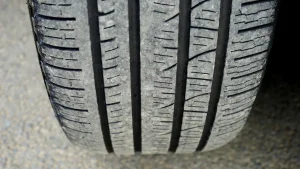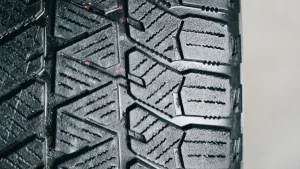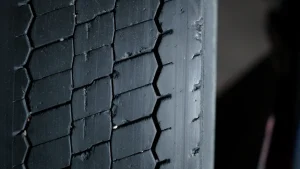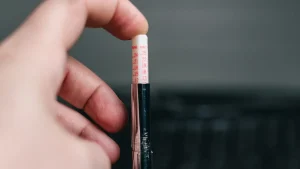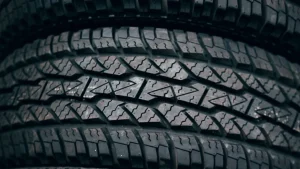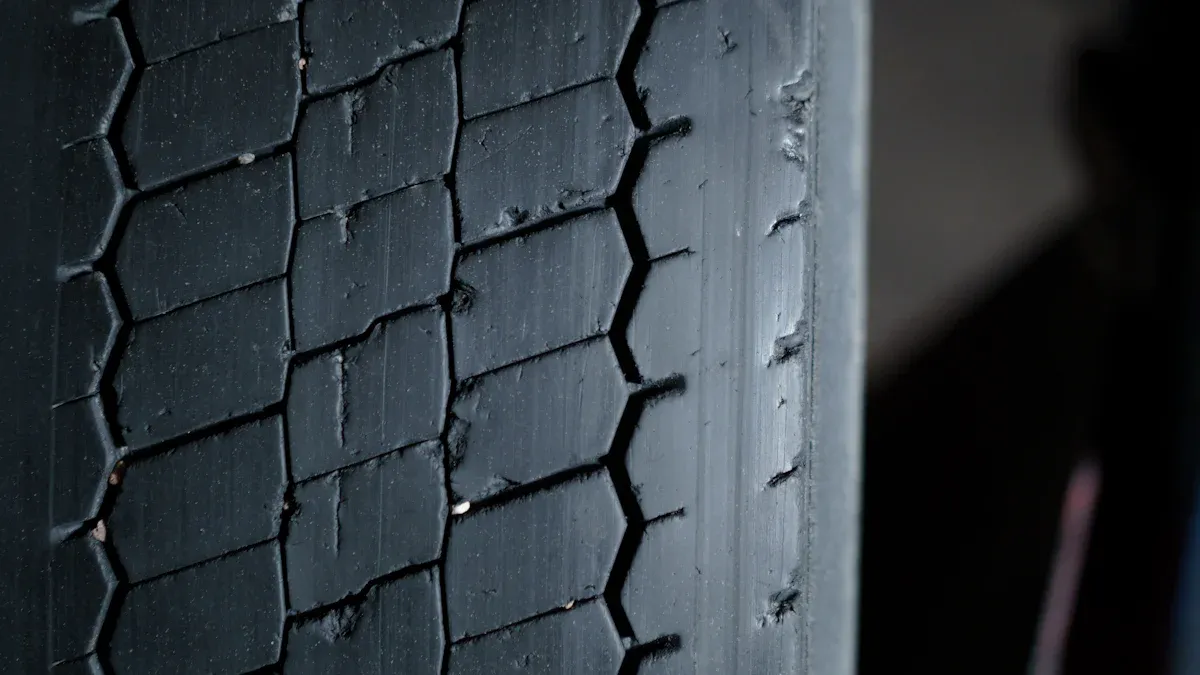
Maintaining your tyres is very important for safe driving. One significant issue you might encounter is when your tyres are worn on the inside edge. This type of wear can lead to serious safety risks. In fact, 75% of tyre problems in deadly accidents stem from neglecting their care. Spotting early signs of tyre worn on inside edge can help you avoid costly repairs. It also ensures your safety on the road. Regular checks can greatly enhance your driving experience.
Pontos-chave
Check your tyres often for inside edge wear. This helps you find problems early.
Keep the right tire pressure. This stops uneven wear and helps tires last longer.
Rotate your tyres every 5,000 miles. This makes sure all tires wear evenly.
Make sure your wheels are aligned well. This helps you control your vehicle better and reduces wear.
Drive safely to reduce tire wear. This also improves how your vehicle performs overall.
Signs of Inside Edge Wear
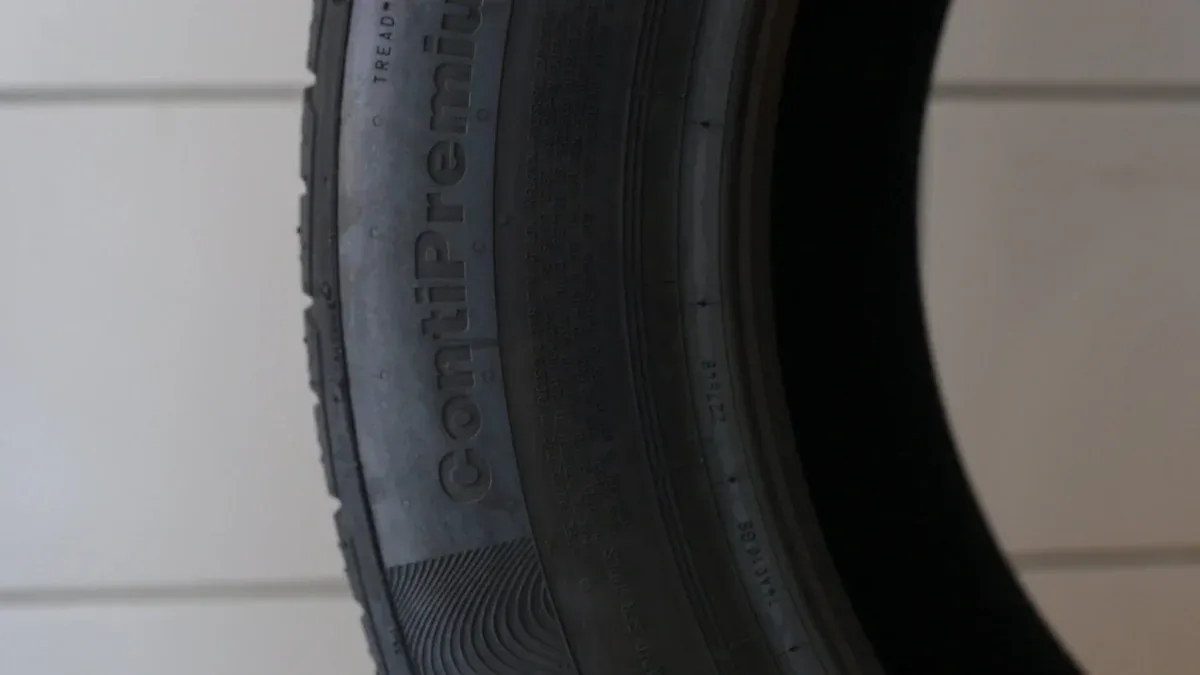
Indicadores Visuais
When you check your tyres, look for signs of inside edge wear. Here are some important signs to notice:
Side Wear (Camber Wear): This wear shows up on the inner edge of the tyre. It usually means there are alignment problems. You can see this easily during regular checks.
Tread Depth Discrepancy: The tread depth on the inner edge may be much less than on the outer shoulder.
Tread Depth Location | Tread Depth Comparison |
|---|---|
Inner Edge | |
Outer Shoulder | At least 50% greater than inner edge |
These signs can help you find uneven tyre wear early. This way, you can fix it before it causes bigger issues.
Performance Changes
Inside edge wear can change how your vehicle drives. You might see several performance changes, such as:
Decreased Grip: Worn tyres, especially on the inside edge, lose grip. This makes braking take longer since the tyres can’t slow down well.
Compromised Handling: Inside edge wear often goes with negative camber and toe-out. These problems can make your vehicle feel unstable when turning.
Increased Sliding Resistance: The area where the tyre meets the road gets smaller, which raises sliding resistance. This can make turning harder and less stable.
Also, if your vehicle has weak springs or worn suspension bushings, it might sit lower. This change in suspension can make the wear worse, especially in cars with independent rear suspension.
By spotting these signs and performance changes, you can quickly deal with tyre worn on the inside edge. This helps keep you safe and extends the life of your tyres.
Causes of Tyre Worn on Inside Edge
Tyre wear on the inside edge usually comes from some mechanical problems. Knowing these causes can help you prevent issues and keep your vehicle safe.
Problemas de Desalinhamento
Misalignment is a main reason for uneven tire wear, especially on the inside edge. When your vehicle’s wheels are not lined up right, it can cause quick wear. Here are some common alignment problems:
Toe-out: This happens when the front of the tires points away from each other. It makes the inside edge of the tire drag on the road, causing more wear.
Negative camber: When the top of the tire leans inward, it makes the vehicle ride on the inside of the tires. This leads to more wear in that area.
Misalignment problems, especially with camber or toe settings, can cause quick edge wear on tires. Checking your wheel alignment regularly is very important. Experts suggest checking your tire alignment every 6,000 miles or at least once a year. This helps you find any misalignment early and stop uneven tire wear.
Suspension Problems
Your vehicle’s suspension system is very important for tire wear. Worn suspension parts can cause uneven tire wear patterns. Here are some key things to think about:
Worn ball joints: If the inner or outer edges of your front tires wear out faster than the rest, worn ball joints might be the problem.
Control arms and bushings: Any wear or issues with these parts can lead to uneven tire wear. Damaged control arms or bushings can greatly change how your tires touch the road.
Driving habits also affect inside tire wear. Fast cornering, quick starts, and hard stops can create extra friction. This friction causes uneven tire wear and raises the chance of tread separation. For example, during sharp turns, the outer edge of the tires feels a lot of force, causing faster edge wear.
Keeping the right tire pressure is also very important. Overinflated tires often wear too much on the inner edges, while underinflated tires can cause uneven wear patterns. So, keeping your tires properly inflated is key for good performance and long life.
By knowing these causes, you can take steps to stop tyre worn on the inside edge. Regular checks and maintenance will help keep your vehicle safe and your tires in great shape.
Inspecting for Uneven Tire Wear
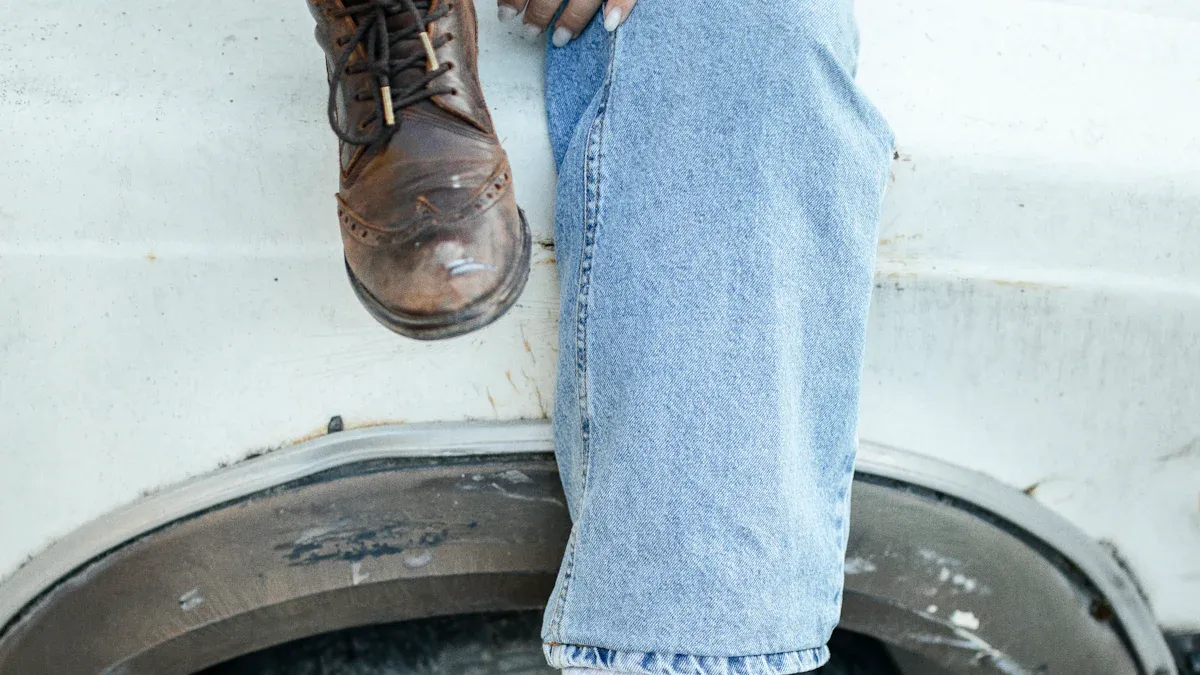
Tools Needed
To check your tyres for uneven wear, gather these tools:
Medidor de Profundidade do Piso: This tool measures tread depth. It shows early signs of inside edge tyre wear.
Alignment Tools: These tools help check your vehicle’s wheel alignment. They find misalignment problems that cause uneven tire wear.
Air Pressure Gauge: Use this to check your tire pressure. Keeping the right tire pressure is important to avoid uneven wear.
Flashlight: A flashlight helps you see well when checking the inner edges of your tyres.
Inspection Process
Follow these steps to check your tyres for inside edge wear:
Visual Inspection: Start by looking at the inner and outer edges of each tyre. Check for too much wear on both sides, which shows edge wear.
Check Tread Depth: Use your tread depth gauge to measure the tread depth. Big differences in tread depth among tyres mean maintenance is needed.
Inspect Tire Pressure: Make sure the tyre is inflated to the recommended Cold Tire Inflation Pressure. Do not go over the Maximum Cold Tire Inflation Pressure on the tyre sidewall.
Look for Alignment Issues: Check if the wheels lean too much to one side. This may show misalignment. If you see this, think about getting a professional alignment check.
Rotate Tires Regularly: Experts say to rotate tyres every 5,000 miles or every six months. This helps stop uneven tire wear and makes your tyres last longer.
By following these steps, you can find uneven tire wear and act before it causes bigger problems. Regular checks will keep your vehicle safe and improve your driving experience.
Importance of Addressing Tyre Wear
Implicações de Segurança
Ignoring tyre wear, especially on the inside edge, can be very dangerous. You might have less grip, especially on wet roads. This can make it easier to lose control of your vehicle. Worn tyres also take longer to stop. In emergencies, this delay can lead to serious problems.
Here are some specific safety risks linked to inside tire wear:
Increased stopping distances: Worn tyres need more time to stop, which is risky.
Higher risk of blowouts: Tyres with low tread or damage are more likely to burst.
Decreased grip: This can cause loss of control, especially during quick turns.
Cost of Neglect
Not paying attention to inside tire wear can also cost you a lot of money. The price of getting new tyres can add up fast. For example, here’s a list of estimated costs for different types of vehicles:
Vehicle Type | Estimated Cost of a New Set of Tires |
|---|---|
Compact Car | $400 – $800 |
Midsize Sedan | $500 – $1,000 |
SUV | $600 – $1,200 |
Truck | $800 – $1,500 |
Besides replacing tyres, you might have to pay for repairs on other parts of your vehicle that are affected by uneven tire wear. These can include:
Suspension System Damage: $300 – $1,500
Wheel Alignment Issues: $50 – $150
Transmission Repairs: $1,000 – $5,000
By fixing problems like misalignment or low air pressure early, you can avoid changing tyres often. This smart choice can save you a lot of money over time. Also, changing tyres too soon creates waste and uses up resources, which is bad for the environment.
Taking care of your tyres keeps you safe and saves you money in the future. Regular checks and maintenance can help you avoid the problems of tyre worn on inside edge.
In conclusion, finding and fixing tyre worn on the inside edge is very important for your vehicle’s safety and how well it drives. Here are some main points to remember:
Keep the right tire pressure to stop uneven wear.
Change the position of your tires to share wear evenly.
Make sure your wheels are aligned to prevent quick wear and improve control.
Watch how you drive, since it can change how long your tires last.
By doing these things, you can lower the chance of inside edge tyre wear. Regular checks and professional alignments will help keep your vehicle safe and your tires in good condition.
Perguntas Frequentes
What causes inside edge tyre wear?
Inside edge tyre wear usually happens because of misalignment, negative camber, or suspension problems. These issues make the inner edge touch the road more than the outer edge, causing it to wear out faster.
How can I prevent inside edge tyre wear?
To stop inside edge tyre wear, check your wheel alignment often. Keep the right tire pressure and rotate your tires every 5,000 miles. Doing these things helps your tires wear evenly and last longer.
How often should I check my tyres?
You should check your tyres at least once a month. Look for wear signs, check the tread depth, and make sure they are properly inflated. Regular checks help you find problems early and keep you safe.
Can I fix inside edge wear myself?
You can do visual checks and measure tire pressure, but fixing inside edge wear usually needs professional help. You should see a mechanic for a correct diagnosis and any needed repairs.
What are the signs of misalignment?
Signs of misalignment include uneven tire wear, your vehicle pulling to one side, and a steering wheel that is not straight. If you see these signs, get your alignment checked by a professional.
Veja Também
Dominar os medidores de profundidade da banda de rodagem dos pneus para medições precisas
A Importância de Monitorizar a Profundidade do Piso dos Pneus para Segurança
Compreender Detectores de Profundidade do Piso dos Pneus Inteligentes e o Seu Funcionamento

